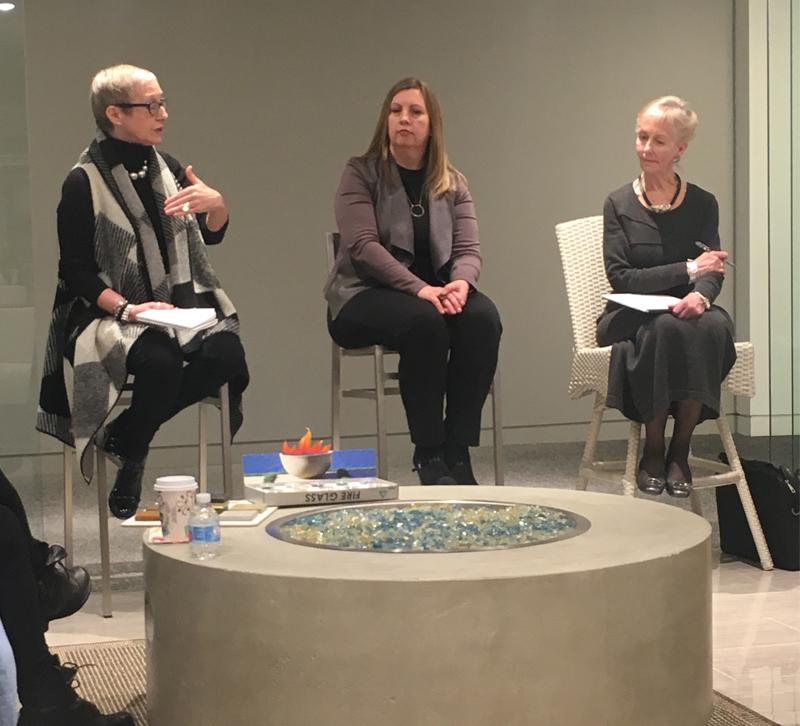The Outdoor Design Conference is happening today at Chicago's Merchandise Mart. Now in its sixth year, the conference brings interior designers together for a day of education and networking.
The day started off strong with a great discussion on senior living at aging-in-place. Hosted by Jon Yedinak, Managing Editor of Senior Housing News, the Senior Living and Aging in Place: Tailoring Outdoor Environments For Your Clients’ Needs took place in the Anacara Co. showroom and generated some great ideas on designing spaces for seniors.
Here's what interior designers need to know.
Memory gardens keep minds active
A little outdoor time can do a lot of good for seniors, especially those living at facilities for people with dementia or Alzheimer's disease. Designers of these spaces, including panelist Misha Mann, have been building memory gardens in these facilities to get residents moving and interacting with their spaces.
For those unfamiliar, a memory garden is an outdoor space with interactive features that inspire the senses, but in a safe environment for people with limited memory capabilities. These gardens may have looping walking paths, small water features and places to sit among flowers and trees. The goal is to get the individual moving and to interact with the environment, so there may be mailboxes and low-level gates with doors to open and close and other accessories that individuals can touch and experience using every sense.
"We're really touching all these experiences and giving people something to do," Mann said.
How to apply to your designs: Retired seniors need to be outdoors as well, even those not suffering from memory issues. For your retired clients, you should be making the outdoors an important part of your design. Do not let these clients neglect their outdoor spaces.
Bring the outdoors in for health's sake — without breaking the bank
For any designer that's ever looked into getting a building LEED-certified, it is a lengthy and expensive building and certification process. While sustainability is important in buildings, residential clients don't always have the budget to add solar panels and other features. But you don't have to spend so much money in order to get a bit of the outdoors in, according to panelist and WELL-certification advocate Jase Frederick.
Frederick said humans spend 90 percent of their time indoors, and retired seniors spend even more time indoors. Yet, studies have shown that people who are active outdoors are healthier, less stressed and generally happier than those who rarely go outside. No designer can ever force clients out of their houses, but there are ways to help them get the benefits of being outdoors.
How to apply to your designs: One thing clients don't often think about is their indoor air quality, mainly the humidity within the home. Having windows that can open around the home and installing air quality systems that monitor the air indoors can help clients take advantage of fresh air and improve the quality of life for those with asthma and other air sensitivities.
Furniture and color selection matters
Everyone wants a stylish outdoor space, but with seniors and those aging-in-place, a safe environment takes precedent. That's why designers have to think carefully about the furniture and color selections they make for these clients.
For furniture, rounded products work best for seniors because they are easier on the skin. As Letty Allen, owner and designer at Mature Transitions By Design explained, seniors have sensitive skin. It bruises easily, and hard corners can tear skin, often without the person knowing it. Rounded corners, arms and sides lessen the chances of a senior getting bruises and cuts just by trying to sit in a chair.
Color selection is also more important with outdoor spaces for those aging-in-place. Although a client may have good eyesight while you're working with them, that eyesight will probably deteriorate, and Alan says depth perception is often affected, which can lead to trips and falls. Bright colors, or just different colors, can help seniors determine where an object is.
How to apply to your designs: Choose contrasting colors and finishes. Do not stick to neutrals. You need colors that stand out, so even if a client's eyes do get worse over time, they can still see where a piece of furniture is — without having to trip in front of it first.







